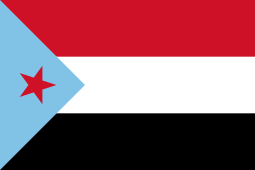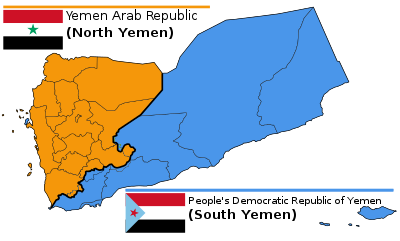South Yemen
South Yemen, officially the People's Democratic Republic of Yemen (Arabic: جمهورية اليمن الديمقراطية الشعبية Jumhūriyat al-Yaman ad-Dīmuqrāṭīyah ash-Sha'bīyah), also referred to as Democratic Yemen or Yemen (Aden), was a country that existed from 1967 to 1990 as a state in the Middle East in the southern and eastern provinces of the present-day Republic of Yemen, including the island of Socotra.
People's Democratic Republic of Yemen جمهورية اليمن الديمقراطية الشعبية Jumhūrīyat al-Yaman ad-Dīmuqrāṭīyah ash-Sha'bīyah | |||||||||||
|---|---|---|---|---|---|---|---|---|---|---|---|
| 1967–1990 | |||||||||||
.svg.png) Coat of arms
| |||||||||||
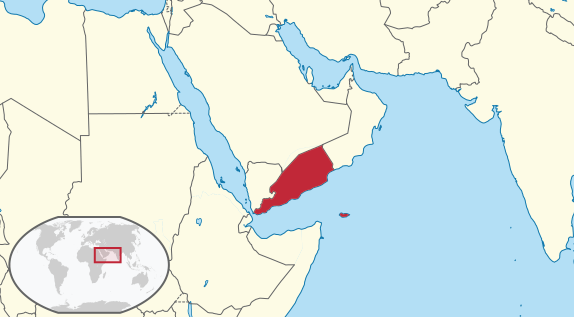 The People's Democratic Republic of Yemen in 1989 | |||||||||||
| Status |
| ||||||||||
| Capital and largest city | Aden | ||||||||||
| Common languages | |||||||||||
| Government | Marxist–Leninist one-party socialist republic | ||||||||||
| General Secretary | |||||||||||
• 1978–1980 | Abdul Fattah Ismail | ||||||||||
• 1980–1986 | Ali Nasir Muhammad | ||||||||||
• 1986–1990 | Ali Salim al-Beidh | ||||||||||
| President | |||||||||||
• 1967–1969 (first) | Qahtan al-Shaabi | ||||||||||
• 1986–1990 (last) | Haidar al-Attas | ||||||||||
| Prime Minister | |||||||||||
• 1969 | Faysal al-Shaabi | ||||||||||
• 1969–1971 | Muhammad Ali Haitham | ||||||||||
• 1971–1985 | Ali Nasir Muhammad | ||||||||||
• 1985–1986 | Haidar al-Attas | ||||||||||
• 1986–1990 | Yasin Said Numan | ||||||||||
| Legislature | Supreme People's Council | ||||||||||
| Historical era | Cold War | ||||||||||
• Independence declared | 30 November 1967 | ||||||||||
• UN membership | 14 December 1967 | ||||||||||
• Constitution adopted | 31 October 1978 | ||||||||||
• Unification | 22 May 1990 | ||||||||||
| Area | |||||||||||
| 1990 | 360,133 km2 (139,048 sq mi) | ||||||||||
| Population | |||||||||||
• 1990 | 2,585,484 | ||||||||||
| Currency | South Yemeni dinar | ||||||||||
| Calling code | 969 | ||||||||||
| |||||||||||
South Yemen's origins can be traced to 1874 with the creation of the British colony of Aden and the Aden Protectorate, which consisted of two-thirds of the present-day Yemen. However, Aden became a province within the British Raj in 1937. After the collapse of Aden Protectorate, a state of emergency was declared in 1963 when the National Liberation Front (NLF) and the Front for the Liberation of Occupied South Yemen (FLOSY) rebelled against British rule.
The Federation of South Arabia and the Protectorate of South Arabia merged to become the People's Republic of Southern Yemen on 30 November 1967 and later changed its name to the People's Democratic Republic of Yemen and became a Marxist–Leninist one-party state in 1969 supported by Cuba, East Germany and the Soviet Union. It was the only communist state to be established in the Arab world.[2] Despite its efforts to bring stability into the region, it was involved in a brief civil war in 1986. With the collapse of communism, South Yemen was unified with the Yemen Arab Republic (commonly known as "North Yemen") on 22 May 1990 to form the present-day Yemen. After three years, however, a political crisis arose between the South's YSP and the North's GPC and Islah parties after the parliamentary elections in 1993. A year later, South Yemen declared its secession from the North in 1994 and a new, unrecognized secessionist state, the Democratic Republic of Yemen, which ended with its dissolution and the North occupying South Yemen after the 1994 civil war. 23 years later, another attempt to restore South Yemen (as only a country, not a socialist state) with the Southern Transitional Council as its new government continues on since 2017.
History
British rule
In 1838, Sultan Muhsin Bin Fadl of the state of Lahej ceded 194 km² (75 sq. miles) including Aden to the British. On 19 January 1839, the British East India Company landed Royal Marines at Aden to occupy the territory and stop attacks by pirates against British shipping to India. It then became an important trading hub between British India and the Red Sea, and following the opening of the Suez canal in 1869, it became a coaling station for ships en route to India. Aden was ruled as part of British India until 1937, when the city of Aden became the Colony of Aden. The Aden hinterland and Hadhramaut to the east formed the remainder of what would become South Yemen and was not administered directly by Aden but were tied to Britain by treaties of protection with local rulers of traditional polities that, together, became known as the Aden Protectorate. Economic development was largely centered in Aden, and while the city flourished, the states of the Aden Protectorate stagnated.
Decolonization
In 1963, Aden and much of the Protectorate were joined to form the Federation of South Arabia with the remaining states that declined to join, mainly in Hadhramaut, forming the separate Protectorate of South Arabia. Both of these polities were still tied to Britain with promises of total independence in 1968. Two nationalist groups, the Front for the Liberation of Occupied South Yemen (FLOSY) and the National Liberation Front (NLF), began an armed struggle known as the Aden Emergency on 14 October 1963 against British control and, with the temporary closure of the Suez Canal in 1967, the British began to withdraw. One faction, NLF, was invited to the Geneva Talks to sign the independence agreement with the British. However, Britain - who during its occupation of Aden signed several treaties of protection with the local sheikhdoms and emirates of the Federation of South Arabia - excluded them in the talks and thus the agreement stated "...the handover of the territory of South Arabia to the (Yemeni) NLF...". Southern Yemen became independent as the People's Republic of Southern Yemen on 30 November 1967, and the National Liberation Front consolidated its control in the country.
In June 1969, a radical Marxist wing of the NLF gained power and on 1 December 1970, reorganized the country into the People's Democratic Republic of Yemen (PDRY). Subsequently, all political parties were amalgamated into the National Liberation Front, renamed the Yemeni Socialist Party, which became the only legal party. The People's Democratic Republic of Yemen established close ties with the Soviet Union, the People's Republic of China, Cuba, and the Palestinian Liberation Organization. East Germany's constitution of 1968 even served as a kind of blueprint for the PDRY's first constitution.[3]
The new government embarked on a programme of nationalisation, introduced central planning, put limits on housing ownership and rent, and implemented a land reform. By 1973, the GDP of South Yemen increased by 25 percent.[4] And despite the conservative environment and resistance, women became legally equal to men, polygamy, child marriage and arranged marriage were all banned by law. Equal rights in divorce were also sanctioned. The Republic also secularised education and sharia law was replaced by a state legal code.[5]
The major communist powers assisted in the building of the PDRY's armed forces. Strong support from Moscow resulted in Soviet naval forces gaining access to naval facilities in South Yemen.
Disputes with North Yemen
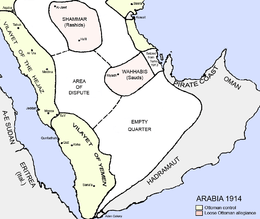
Unlike the early decades of East Germany and West Germany, North Korea and South Korea, or North Vietnam and South Vietnam, the Yemen Arab Republic (North Yemen) and South Yemen (PDRY) remained relatively friendly, though relations were often strained. Fighting broke out in 1972, and a short-lived, small proxy border conflict was resolved with negotiations, where it was declared unification would eventually occur.[6][7]
However, these plans were put on hold in 1979, as the PDRY funded Red rebels in the YAR, and war was only prevented by an Arab League intervention. The goal of unity was reaffirmed by the northern and southern heads of state during a summit meeting in Kuwait in March 1979.
In 1980, PDRY president Abdul Fattah Ismail resigned and went into exile in Moscow, having lost the confidence of his sponsors in the USSR.[8] His successor, Ali Nasir Muhammad, took a less interventionist stance toward both North Yemen and neighbouring Oman.
Civil War
On January 13, 1986, a violent struggle began in Aden between Ali Nasir's supporters and supporters of the returned Ismail, who wanted power back. Fighting, known as the South Yemen Civil War, lasted for more than a month and resulted in thousands of casualties, Ali Nasir's ouster, and Ismail's death. Some 60,000 people, including the deposed Ali Nasir, fled to the YAR. Ali Salim al-Beidh, an ally of Ismail who had succeeded in escaping the attack on pro-Ismail members of the Politburo, then became General Secretary of the Yemeni Socialist Party.[9]
Reforms and attempts for unification
Against the background of the perestroika in the USSR, the main backer of the PDRY, political reforms were started in the late 1980s. Political prisoners were released, political parties were formed and the system of justice was reckoned to be more equitable than in the North. In May 1988, the YAR and PDRY governments came to an understanding that considerably reduced tensions including agreement to renew discussions concerning unification, to establish a joint oil exploration area along their undefined border, to demilitarize the border, and to allow Yemenis unrestricted border passage on the basis of only a national identification card. In 1990, the parties reached a full agreement on joint governing of Yemen, and the countries were effectively merged as Yemen.
Reviving South Yemen
Since 2007, some Southerners have been actively protesting for independence, in a movement known as 'Al Hirak' or the Southern Movement. During the Yemen Civil War 2015, in response to incursions by the Houthis and military forces loyal to deposed Yemeni president Ali Abdullah Saleh, members of the Southern Movement formed 'Popular Resistance' militias. Since the Battle of Aden, these armed groups have sought to defend the South against Houthi/Saleh attempts to take over the country and have taken the current state of civil war as an opportunity to further their struggle for independence.
In late January 2018, separatists loyal to the Southern Transitional Council successfully seized control of the Saudi-backed Yemeni government headquarters in Aden in an apparent coup d'état against the Hadi government.[10][11]
Politics and social life
South Yemen's ethnic groups are Arabs (92.8%), Somalis (3.7%), Afro-Arab 1.1%, Indians and Pakistanis (1%), and other (1.4%) (2000). The only recognized political party in South Yemen was the Yemeni Socialist Party, which ran the country and the economy along self-described Marxist lines, modeled on the Soviet Union.[12]
The constitution prescribed universal suffrage.
The Supreme People's Council was appointed by the General Command of the National Liberation Front in 1971.
In Aden, there was a structured judicial system with a supreme court.
Education was paid for through general taxation.
There was no housing crisis in South Yemen. Surplus housing built by the British meant that there were few homeless people in Aden, and people built their own houses out of adobe and mud in the rural areas.
South Yemen developed as a Marxist, mostly secular[13] society ruled first by the National Liberation Front, which later morphed into the ruling Yemeni Socialist Party. The only avowedly Marxist nation in the Middle East, South Yemen received significant foreign aid and other assistance from the USSR[14] and East Germany, which stationed several hundred officers of the Stasi in the country to train the nation's secret police and establish another arms trafficking route to Palestine.[15] The East Germans didn't leave until 1990, when the Yemeni government declined to pay their salaries which had been terminated with the dissolution of the Stasi during German reunification.[16]
Sports
In 1976, the South Yemen national football team participated in the Asia Cup, where the team lost to Iraq 1-0 and to Iran 8–0. They entered their only World Cup qualification campaign in 1986 and were knocked out in the first round by Bahrain. On September 2, 1965, South Yemen played their first international match against the United Arab Republic, to whom they lost 14–0. On November 5, 1989, South Yemen played its last international match against Guinea, to whom they lost 1–0. The team stopped playing when the North and South united in 1990 to form the modern state of Yemen.
In 1988, the South Yemen Olympic team made its debut in Seoul. Sending only eight athletes, the country won no medals. This was the only time the country went to the Olympics until unification in 1990.
Governorates
Following independence, South Yemen was divided into six governorates (Arabic sg. muhafazah), with roughly natural boundaries, each given a name by numeral. From 1967 to 1978, they were named officially by numerals only; from 1979 to 1990, they were given new official names. The islands: Kamaran (until 1972, when it was seized by North Yemen), Perim (Meyun), Socotra, Abd-el-Kuri, Samha (inhabited), Darsah and others uninhabited from the Socotra archipelago were districts (mudiriyah) of the First/Aden Governorate being under Prime-Minister of the state supervision.[17]
| Numeral | Name | Approximate Area (km.²) | Capital | 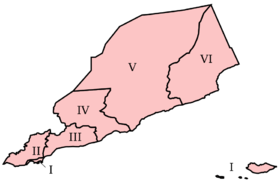 Map of the governorates |
|---|---|---|---|---|
| I | 'Adan | 6,980 | Aden | |
| II | Lahij | 12,766 | Lahij | |
| III | Abyan | 21,489 | Zinjibar | |
| IV | Shabwah | 73,908 | Ataq | |
| V | Hadhramawt | 155,376 | Mukalla | |
| VI | al-Mahrah | 66,350 | Al Ghaydah |
Economy
There was little industrial output, or mineral wealth exploitation, in South Yemen, until the mid-1980s, following the discovery of significant petroleum reserves in the central regions near Shibam and Mukalla. The main sources of income were agriculture, mostly fruit, cereal crops, cattle and sheep, fishing and later, oil exports.
The national budget was 13.43 million dinars in 1976, and the gross national product was US$150 million. The total national debt was $52.4 million.
Airlines
The following airlines had operated from the PDRY:[18]
- Aden Airways[19] (1949–1967). Ceased operations on 30 June 1967 at the time of British withdrawal from the Federation and the Protectorate of South Arabia.
- Alyemda – Democratic Yemen Airlines (1961–1996). Joined Yemenia, the airline of the former YAR
- Yemen Airways (1989–1990)
See also
References
- Clark, Victoria. Yemen: Dancing on the Heads of Snakes, Yale University Press: 2010, page 112-130.
- Saudi Arabia and the Civil War within Yemen's Civil War
- Müller, Miriam M. (2015). A Spectre is haunting Arabia - How the Germans brought their Marxism to Yemen. Bielefeld: Transcript. pp. 257ff. ISBN 978-3-8376-3225-5. Archived from the original on 2016-05-30. Retrieved 2016-05-30.
- Bayat, Asef (2017). Revolution without Revolutionaries: Making Sense of the Arab Spring. California, US: Stanford University Press. p. 5. ISBN 9780804799027.
- Molyneux, Maxine; Yafai, Aida; Mohsen, Aisha; Ba'abaad, Noor (1979). "Women and Revolution in the People's Democratic Republic of Yemen". Feminist Review (1): 4–20.
- "North and South Yemen: In Search of Unity", CIA Study on Yemeni Unification, Central Intelligence Agency, January 19, 1990, archived from the original on March 5, 2016, retrieved September 14, 2017 – via Scribd
- Gause, Gregory (1990). Saudi-Yemeni relations: domestic structures and foreign influence. Columbia University Press. p. 98. ISBN 9780231070447.
- Halliday, Fred (2002). Revolution and Foreign Policy: The Case of South Yemen, 1967–1987. Cambridge University Press. p. 35.
- Katz, Mark (Fall 1986). "Civil Conflict in South Yemen" (PDF). Middle East Review. Archived from the original (PDF) on 2011-07-18.
- "Separatist clashes flare in south Yemen". 30 January 2018. Archived from the original on 29 January 2018. Retrieved 30 January 2018 – via www.BBC.com.
- "Yémen: les séparatistes sudistes, à la recherche de l'indépendance perdue". Le Point. 28 January 2018. Archived from the original on 28 January 2018. Retrieved 28 January 2018.
- "Middle East :: Yemen — The World Factbook - Central Intelligence Agency". www.cia.gov. Retrieved 2020-06-23.
- Laessing, Ulf (January 22, 2010). "Women of southern Yemen port remember better times". Reuters. Archived from the original on September 24, 2015. Retrieved July 2, 2017.
- Gart, Murray (January 9, 1989). "South Yemen New Thinking in a Marxist Land". Time. Archived from the original on August 25, 2013. Retrieved June 23, 2017.
- Müller, Miriam Manuela. A Spectre Is Haunting Arabia: How the Germans Brought Their Communism to Yemen. Transcript, 2015.In-text Citation
- Stokes, Lee. “East German Security Quit South Yemen.” United Press Agency, 11 May 1990.In-text Citation
- Ismael, Tareq Y.; Jacqueline S. Ismael (October 1986). The People's Democratic Republic of Yemen: Politics, Economics, and Society; The Politics of Socialist Transformation. Lynne Rienner Pub. ISBN 978-0-931477-96-6.
- "Airlines - South Yemen". The World's Airlines. David Lyall. Archived from the original on 2009-06-27. Retrieved 2009-07-13.
- "History". Aden Airways. Peter Pickering. Archived from the original on 2009-04-27. Retrieved 13 July 2009.
![]()
External links
| Wikimedia Commons has media related to South Yemen. |
- South Yemen Anthem (1969-1979)
National anthem of Yemen (Second and Last Anthem of South Yemen)
